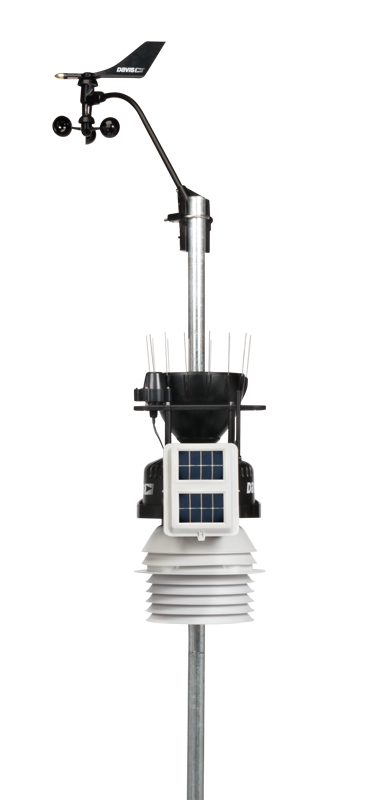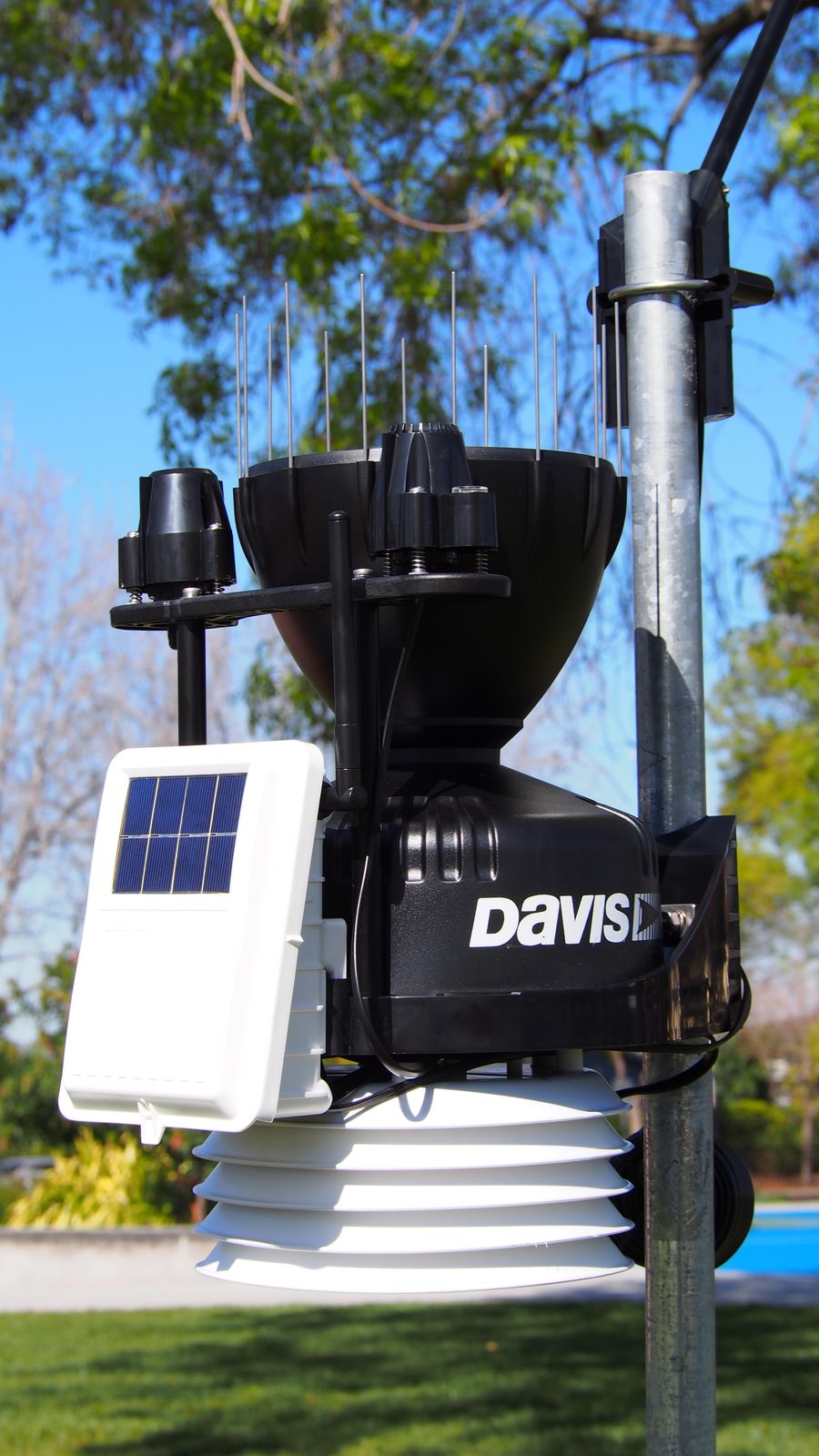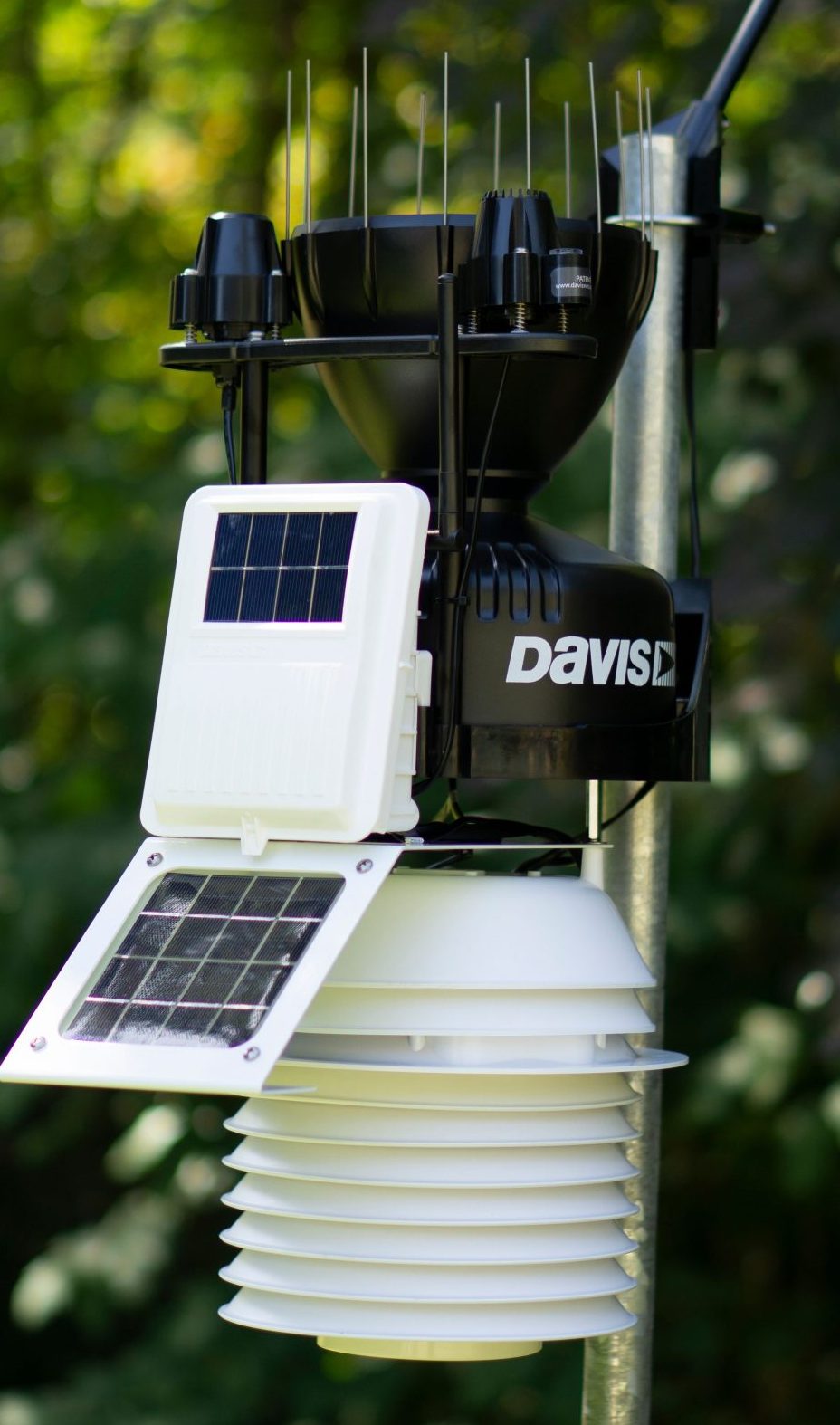There is a wide choice of extra sensors and accessories that can be added to wireless Vantage Pro 2 stations to allow the design of sophisticated environmental monitoring systems. While the options described below can mostly all be added to a complete standard VP2 station such as a 6152 or 6162 model (which is typically the most cost-effective way of buying an initial Davis station), they can also be used to build up a bespoke configuration. For example, users requiring a Connect-based system for use at a remote location will typically not need a display console and so a configuration can be assembled from e.g. Connect + ISS (main sensor transmitter) + any other additional sensors and transmitters that may be required. The recently introduced Weatherlink Live units allow even more flexibility in station configurations.
The options include:
- Separate ISS and console units;
- Solar radiation and UV sensors;
- Fan-assisted radiation shields (FARS) and standalone passive shields;
- Supplementary stations to measure temperature/humidity, soil moisture and leaf wetness;
- A separate wireless anemometer transmitter;
- New Replacement rain gauges;
Each of these types of accessories is introduced below. Please contact us with any further questions on how best to include these items in a system configuration.
Other installation accessories, including secondary display consoles, are described on the Davis System Accessories page.
Important: Consoles vs Weatherlink Live
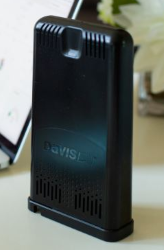
It is important to appreciate that the introduction of the Weatherlink Live upload device has allowed the number and type of supplementary sensors (as described below) that can be added to a single VP2 station to increase considerably. Before Weatherlink Live came along, all supplementary sensor reception had to be made by a standard VP2 console (or Envoy) and this was subject to some rigid rules, eg only a single active anemometer or rain gauge or 6345 soil moisture/temperature station per system; only two temp/hum or three supplementary temperature stations can be logged; and there are other limitations too. All these rules still apply to VP2 stations, though this does not of course lessen the value of adding supplementary sensors provided the rules are observed.
But a Weatherlink Live unit allows the rules to be broken in multiple ways, eg:
- Literally any mix of transmitters (including multiple ISS units, 6332 multi-sensor transmitters, anemometers, rain gauges and 6345 soil moisture etc transmitters) is allowed on all eight wireless channels;
- Solar and UV sensors no longer need to be on the main ISS transmitter;
- A 6332 supplementary multi-sensor transmitter can, if the user wishes, have all five of its inputs occupied. (With a VP2 console only one input can be used.);
- Supplementary temperature readings can be received to full 0.1°F or C resolution. (VP2 consoles are limited to 1°F resolution for such readings.);
Note though that older software such as Weatherlink for Windows will not be compatible with Weatherlink Live units. The most flexible software to use for Weatherlink Live is the Davis weatherlink.com online platform, though some other modern software such as CumulusMX or weewx may be at least partially compatible (ie some supplementary sensors will be receivable but not necessarily all).
ISS add-ons
The description of add-ons and supplementary sensors is broken into two sections. This first part lists add-ons for the primary ISS (main sensor assembly) in a station, ie alternative ISS units; solar and UV sensors; and fan-assisted shields. The second section further below details the various additional transmitters and sensors that can be added into a station.
Alternative ISS units
It’s worth noting that VP2 ISS (the main sensor transmitter, which always includes the anemometer) and console units are all available as separate items. These units are described in detail on other VP2 pages – please see the subitems on the main VP2 menu for further information.
There are also four other ISS units that are not available packaged in a complete station and that therefore need to be specified with some other receiver unit such as a standard console or – for wireless systems – a Weatherlink Live unit or a Connect unit (assuming that they’re not simply being bought as a replacement for an existing but old ISS unit). These are:
- 6334OV – ISS for agriculture: This is a standard VP2 ISS (part 6322OV) that is supplied factory fitted with two extra options – a solar sensor and a Daytime-only fan shield (see further below for details of both of these extra parts). These makes the 6334 ISS especially suitable for use in many agricultural applications since the solar sensor provides added information about growing conditions and allows ET calculations, while the DFARS shield provides more accurate temperature data. The 6334 ISS is therefore an ideal partner to a Connect unit for remote field installations. The 6334 unit is also a cost-effective way to buy this particular mix of sensors and has the added advantage that the fan unit is factory fitted, so saving installation time;
- 6825OV: This is the direct equivalent of the 6334 ISS, but fitted with the 24-hour fan-assisted shield rather than the DFARS fan unit;
Both 6334 and 6825 units are also available as cabled units if required (6334C and 6825C respectively).
Solar radiation and UV sensors
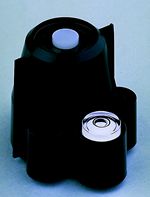
All Vantage Pro 2 stations – cabled and wireless – will accept either or both of these two sensors, which are mounted on a small shelf assembly that sits alongside the rain gauge and that needs to be bought as a separate accessory item. Both sensors, together with the mounting shelf, are also available pre-assembled in the VP2 Plus models.
The UV sensor in particular is a relatively expensive item to make and this accounts for the significantly higher cost of the Plus models. Users interested only in the solar radiation sensor – pictured left, though the UV sensor looks similar – can buy this as an accessory (plus mounting shelf) for the standard VP stations at lower cost than buying a VP Plus model. (But for users looking to add both solar and UV sensors soon after buying their initial station, remember that the Plus package price offers a substantial cost saving compared to adding both solar and UV sensors separately).
The solar sensor’s function is to monitor the strength or power of sunshine (mostly in the visible part of the spectrum), obviously an important weather parameter in its own right, but especially relevant also to stations for agricultural applications, for example to allow the calculation of evapotranspiration (ET), which the VP console can display directly. The UV sensor’s main application is in monitoring of UV intensity, which is of particular health-related interest, for example to assess sunburn risk.
Note that the solar sensor measures global solar irradiance levels. This is the sun’s strength in units of watts/square metre and the best objective measure of the sunshine’s power. The VP console has no direct ‘hours of sunshine’ readout, although this can be calculated, to a rough approximation, by the Weatherlink software from logged solar radiation data. More sophisticated algorithms for conversion of logged solar data to sunshine hours are also available in add-on software.
Fan-assisted radiation shields
24-hour FARS shields in the UK
In practice, we don’t encourage use of the 24-hour FARS in the UK, although we’re happy to supply them for customers who still wish to order. In UK winters there can be a succession of short, gloomy days, providing insufficient sunlight to keep the FARS fan spinning. Under these conditions the temperature response may actually end up being worse than with a passive shield. So the Daytime-only FARS may be a better UK choice.
The standard versions of all VP2 stations are fitted with a passive radiation shield to prevent sunlight falling directly on the temperature sensor and hence giving erroneously high readings. This passive shield works well for the great majority of days in the year but, inevitably, on hot, very sunny but calm days eg in midsummer the air temperature inside the shield may be up to 1-2°C above the outside air temperature. For users seeking ultimate temperature accuracy, all VP2 stations can be specified with a fan-assisted radiation shield (FARS) rather than the standard passive type. A fan actively draws a steady flow of air over the temperature sensor and hence reduces any disparity between temperatures inside the shield and outside. In addition to providing more accurate readings of air temperature on calm/sunny days, the FARS shields also improve the responsiveness of temperature readings under weather conditions where air temperature may be changing rapidly.
There are two types of FARS shield available for the VP2 stations:
- The 24-hour FARS shield (see image above left): As its name suggests the fan on this shield is intended to run continuously and this shield therefore has its own separate solar panel and rechargeable batteries. The 24-hour FARS is available only for the wireless VP2 models and is a factory-fit option only – for ordering you need to specify the 6153 (standard VP2 with FARS) or 6163 (VP2 Plus) stations;
-
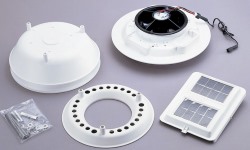
DFARS kit The 7747 Daytime-only FARS (DFARS) shield: This is a simplified and therefore cheaper FARS version that is an add-on to the standard passive VP2 shield and runs off solar power only. As an add-on, it still preserves ventilation by normal breezes (in contrast to the 24-hour FARS, which uses a different and more enclosed shield case). DFARS obviously runs only during the daytime, but this is of course the only time when shield heating effects are likely to be of major concern. This 7747 unit is a user-fitted kit that may be specified with a new station or bought at any time subsequently. Remember that the DFARS kit must be installed by the user but this is a very straightforward job taking maybe 15 minutes – full instructions provided.
The 24-hour and daytime-only FARS units do look superficially similar to one another, but the 24-hour unit has a taller shield with two extra elements plus a more prominent air intake at the bottom, betraying its more enclosed shield design. The other visual clue is that the 24-hour FARS needs its own separate solar panel, whereas in the DFARS unit a supplementary panel is included in a replacement cover for the main SIM board compartment. These differences should be evident in comparing the two pictures above of the 6334 Agricultural ISS and the ISS fitted with the 24-hour FARS.
A FARS shield inevitably adds somewhat to the cost of a VP2 station and many customers conclude that it is an unnecessary luxury for the few days a year in the UK when it might make a material difference to temperature readings. But for those users who are tempted by a FARS shield, the 7747 DFARS kit does offer a good compromise between cost and effectiveness.
Additional transmitters and sensors
There are two distinct wireless transmitter types that may be added to a wireless VP2 station:
- The 6332 Multi-sensor Transmitter;
- The 6345 Soil Moisture.Temperature and Leaf Wetness Transmitter;
Each of these transmitter types will be specified with sensors (purchased separately) to meet the user’s requirements for that particular add-on transmitter. For example, a user requiring an additional temperature humidity sensor would specify the 6332 Multi-sensor Transmitter AND a 6830 temperature/humidity sensor in its own radiation shield.
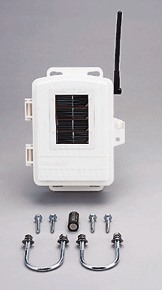
Each transmitter is a wireless-only unit consisting of a wireless transmitter in a weatherproof shelter plus solar-panel door. Note that while Davis may still use the term ‘supplementary station’ to refer to some of these devices, they are not standalone units – a console (or an alternative receiver such as Weatherlink Live or Connect unit) is also still required to receive and display the data. Typically, each supplementary station is mounted completely independently of the main ISS and relays data directly back to the standard VP2 wireless console or other receiver via its own dedicated wireless data channel (and not via the ISS). Cabled VP2 stations cannot be configured with supplementary transmitters.
When considering supplementary transmitters, please remember:
- Supplementary temperature sensors read to a resolution of ±1°F on the standard VP2 and Envoy consoles, rather than the 0.1°C of the ISS temperature sensor. (This is a result of how the supplementary data streams are handled inside the console rather than of poorer intrinsic temperature accuracy). The Weatherlink Live will preserve readings to the full 0.1°F resolution.
- Only certain combinations of supplementary stations can be used to report data back to a VP2 console. Data from all permitted combinations can be viewed on the VP2 console – read how. But Weatherlink Live units can receive from ANY combination of transmitters on all 8 available wireless channels;
- Data from supplementary stations can be logged and handled by the standard Weatherlink logger and software, but there are different constraints on the permitted combinations of numbers and types of sensor as compared to the VP2 console display. Data from Weatherlink Live units can be processed in full via the weatherlink.com platform;
Note: As from 2020, Davis renamed the Anemometer Transmitter to the Multi-sensor Transmitter, although the part number (6332) and the transmitter itself remains completely unchanged. (The new name reflects the fact that since the Weatherlink Live unit can receive from multiple ISS units, the remit of the 6332 transmitter is now much wider than before.)
Also, previously there were two ‘supplementary stations’ called the 6372 Temperature station and 6382 Temperature/Humidity station. Both of these parts are now nominally discontinued. However, the 6372 unit was nothing more than a 6332 box bundled with a temperature sensor and 6382 was a 6332 box bundled with a temp/hum sensor. So both of these ‘stations’ are still readily available except that the 6332 transmitter and 6470 temperature sensor or 6830 temp/hum sensor in a shield now need to be specified separately.
Multi-sensor transmitter
The 6332 multi-sensor transmitter is fitted with exactly the same transmitter board as the standard wireless ISS unit and therefore has identical sensor capabilities. (The only difference is that because it is fitted into a different enclosure, a replacement transmitter board, should it ever be needed, is supplied without the white backplate that an ISS SIM board is usually supplied with.) There are two scenarios in which the multi-sensor transmitter might be used:
Reception by a standard VP2 console
Here, the traditional rules for reception of a supplementary transmitter apply so the transmitter can play one of 3 roles:
- Anemometer Transmitter: In this configuration a 6410 Anemometer would connect to the Wind input of the 6332 box. Thus the anemometer can be completely separated from the main ISS sensor assembly with anemometer and ISS mounted in quite different locations, so allowing much more flexibility and convenience in siting the anemometer. (Normally, the anemometer can be mounted separately from the main assembly, but the two must be connected by cable in order for the anemometer readings to be transmitted back to the console by the single ISS transmitter).Remember that a VP2 console can receive only one set of wind data so use of a supplementary anemometer transmitter means that the wind input from the main ISS is not active. NB This item can also be used in conjunction with a Vantage Vue station.
- Supplementary Temperature Transmitter: A 6470 temperature sensor is attached to the temp/hum input of the 6332 box;
- Supplementary Temperature/Humidity Transmitter: A 6830 type sensor attaches to the temp/hum input of the 6332 box;
These are the only 3 permitted configurations if a VP2 console is used for data reception. And the 3 roles cannot be combined, ie a separate 6332 transmitter is needed for each individual sensor to be connected (and only one anemometer allowed). No other sensors (ie rain/solar/UV) can be connected for console reception. Any number of temperature or temp/hum transmitters are allowed but only 2 temp/hum or 3 temperature can be logged by software.
Reception by a Weatherlink Live unit
The rule here is simple – there are no rules! Any number and any mix of transmitters (up to eight – the maximum number of available wireless channels) can be received by a Weatherlink Live unit and any or all of the inputs on each multi-sensor transmitter can be received in full data resolution. So in theory if a user wanted to connect eight full-house ISS units then this is allowed (of course, every transmitter would need to be in wireless range of the Weatherlink Live unit).
But remember that data from the Weatherlink Live unit needs to be logged by compatible software – the online Davis weatherlink.com service is recommended.
Sensors for the 6332 Multi-sensor Transmitter
If a Weatherlink Live unit is used for reception then literally any of the standard VP2 ISS sensors can be used, others being described elsewhere on this page. If however a standard VP2 console is to be used for reception then the three sensor options would be:
- The standard 6410 VP2 anemometer or the LCJ ultrasonic anemometer;
- A standard 6470 (stainless steel probe) or 6475 temperature sensor on a 7.6m length cable;
- A 6830 type radiation shield with temp/hum sensor – see below:
The 6470/6475 sensors are for applications where an unshielded temperature-only reading is needed and where the temperature probe needs to be positioned in some medium such as water or soil. The 6470 type has a more robust cable and probe and is recommended for use in soil or water immersion. In contrast, the 6830 unit is intended for supplementary readings of air temperature/humidity for which shielding from the sun is essential.
As a further extension to the flexibility of the VP2 sensor range in allowing custom sensor configurations, Davis released the 6830 and 6832 shields. 6830 has the standard passive radiation shield while 6832 has the 24-hour FARS shield (see above). The shield bracket mounts in the usual way either to a pole via U-bolts or to a flat surface such as a wooden fence post.
Both 6830 and 6832 also contain a standard temperature/humidity sensor fitted with a 7.6m cable. The cable simply plugs into the temp/hum socket on any suitable transmitter board whether ISS or supplementary transmitter. The main use of 6380/6382 is likely to be for configurations where it’s preferable to separate the shield and transmitter positions by a significant distance. For example, it allows the transmitter (and its antenna) to be mounted in a high position for maximum wireless range while the sensor is mounted lower down.
Wireless leaf wetness and soil moisture/temperature transmitter
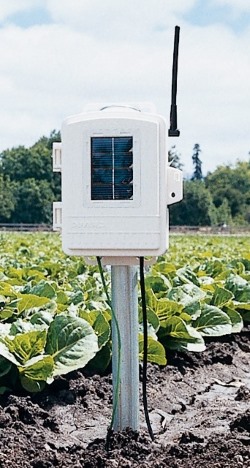

This is effectively a second type of multi-sensor transmitter (shown left – mounting pole not included) to which can be attached a variety of sensor probes for measurements of soil moisture (potentially at different soil depths), and/or of leaf wetness, plus temperature. So, while the 6332 is intended for connecting general-purpose weather sensors (wind, rain, temperature etc), the 6345 station is clearly of most interest to potential agricultural and horticultural users.
Data from all sensors connected to a 6345 transmitter passes back to the display console over a single wireless channel, so making optimal use of the available data bandwidth. The 6345 stations are powered in exactly the same way as the mains ISS, ie a small solar panel is used to supplement the standard lithium battery.
There are three types of sensor which can be fitted to the 6345 transmitter; soil moisture, leaf wetness (shown above right) and temperature. These can be used in various combinations. The temperature sensor is of a similar air/soil/water type as the 6372 station above and can therefore be used to measure the temperature of any medium.
A 6345-based station is specified by adding whichever additional sensor probes may be required to the 6345 transmitter unit itself. Comments on the different types of sensor probes are as follows:
- The 6345 transmitter can be fitted with up to four temperature sensors and can therefore become a specialist temperature-only sensing station if required. Although only one 6345 can be linked to a single VP2 console, it can pass readings from all four sensors to the console across a single wireless channel. But Weatherlink Live units would allow use of any number of 6345 transmitters (up to the maximum of eight).
-
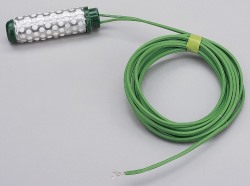
6440 Soil moisture probe The 6345 unit can also accept up to four soil moisture sensors, each probe being supplied with 15′ (4.6m) attached cable. For soil moisture measurements, the moisture reading varies with temperature at the probe depth. The Davis stations are therefore designed to temperature-correct each moisture reading individually, which is achieved most accurately if a moisture probe is paired with its own temperature sensor buried close by and at the same soil depth. So up to four pairs of moisture and temperature probes can be added, for example to assess moisture at different depths at the same location.
- Up to two leaf wetness sensors (see image above right) can also be fitted, both optionally with paired temperature sensors. Leaf wetness sensors are mainly used in agricultural applications to provide data used in predicting disease occurrence, such as potato blight. (But they have also found other imaginative uses, eg as early indicators of rainfall.)
Please remember that supplementary temperature values such as those measured by 6345 sensors are limited to a resolution of 1°F (0.5°C) if received by a standard VP2 console. Weatherlink Live units, as aboev, allow the full 0.1°C data to be recorded.
Additional/Replacement Rain Gauges
These items have now been superseded by the Aerocone and the new updated Tipping Spoon
There are now three variations on the standard VP2 rain gauge that can be used to upgrade or add to an existing VP2 installation:
7857M Rain Collector
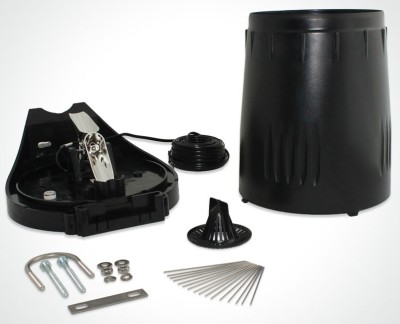
NB 7857M is the metric (0.2mm tip) version of the 7857 gauge. The plain 7857 part number is the imperial (0.01″) version.
7857M (see image right) is the latest standalone version of the familiar 7852 Davis rain gauge, which is enhanced with four new features:
- Base with U-bolt or screw mounting to allow fixing to any suitable stub pole or post. This base is identical to the standard VP2 rain gauge base hence this 7857 gauge could refurbish an ageing VP2 ISS rain gauge;
- Provision for pins (supplied – see bottom centre) to be inserted around the top of the top of the funnel to deter bird-perching. The image below right (click to enlarge) shows the pins after insertion;
- Pronounced grooves in the outer surface of the cone for easier removal for cleaning and maintenance;
- Larger and much improved debris screen (lower centre) which gently clicks home within the funnel;
The combination of all of these new features provides a gauge that can be easily mounted to a convenient pole or post; one that should be much less prone to blocking by extraneous debris; and one that can deliver accurate and cost-effective rainfall measurement (with fine calibration, if required). This standalone version of the gauge is supplied with a 12m cable attached and is fully plug-compatible with the standard VP2 rain gauge input on the ISS. NB This gauge is not suitable for use with the Davis Vue station.
7345.527 Rain collector cone upgrade kit
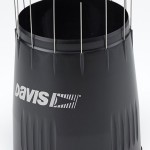
The cone (and anti-perching pins plus new debris screen) from the latest 7857 rain collector is available as a separate kit – see image right (click to enlarge).
This kit can be used to upgrade any existing Vantage Pro or Vantage Pro 2 rain collector (or indeed 7852 standalone WMII-type rain collector) in order to add in the latest ant-blocking features.
Order the most updated version here
7852 Rain collector
The existing/traditional Davis 7852 standalone rain collector with its flat base and lack of anti-blockage protection will continue to be available for as long as stocks last.

